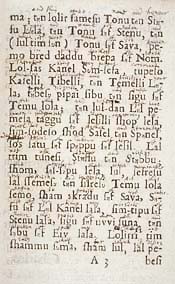George Dalgarno (1626?–87), who was born in Aberdeen and educated at Marischal College, appears to have a kept a private grammar school in Oxford from the mid-1650s. He also worked as a shorthand tutor, and soon came into contact with John Wilkins and Seth Ward (1617–89), the Savilian professor of astronomy.
Dalgarno originally sought to develop an improved, international shorthand, building on earlier models and based on a core vocabulary of significant symbols. His work was encouraged by Wilkins, who was developing his own ideas about a universal language at the same time, and he was taken up by Hartlib, who hoped that Dalgarno’s shorthand might form the basis for a real character. In his excitement, Hartlib responded enthusiastically to a specimen giving John 16:1–13 in Dalgarno’s character: ‘it is so exact and compendious that the whole Bible will be printed in 9 or 10 sheets’ (British Library, Ms. Add. 4377, fol. 149r).
Dalgarno spent part of 1657 living at Hartlib’s house in London, and published proposals for a universal character that ‘shall immediately represent things, and not the sounds of Words’ (British Library, Ms. Add. 4377, fol. 143r). Hartlib publicized Dalgarno’s work extensively at home and abroad, and several of his correspondents gave their opinions of it. Lodwick approved a scheme which was similar to some of his own designs, although he criticized Dalgarno’s method for writing the character. Both John Beale and Robert Wood were sure that Dalgarno’s efforts would lead to an improved shorthand, but were, in Wood’s words, ‘not convinced that it will answer those ends proposed, at least not under a great many yeares’ (Letter to Hartlib, 8th August?1657, Hartlib Papers, 33/1/25A–26B). Sir Cheney Culpeper(1611–63), who offered to patronize Dalgarno, asked ‘Yf Mr Dalgarnoes Characters be non ad placitum imponentis [not placed according to whim], but rationally significante vsque at summos apices [down to the last jot], my next question woulde be whether it be not the same with Adams langwage & (yf not) whether there might not be (a radice) a thirde character framed more easy to the hande & yet as comprehensiue’ (Letter to Hartlib, 20th September 1657, transcribed in Braddick and Greengrass, p.375). Such uncertainty characterized other responses to Dalgarno’s work, and, although plenty of interest was expressed in his schemes, he did not receive the patronage which Hartlib sought for him.
By 1661, Dalgarno had redesigned his plans for a universal language along lines that were similar to those which Wilkins was also following. Jealous of his priority, and still eager for support, Dalgarno published his new scheme in Ars signorum. This was a proper real character, rather than a form of abbreviated writing, which was based not on an agreed lexicon but on a taxonomy of things. Although Dalgarno’s classificatory system was old-fashioned and had only been worked out at an initial level, this was nevertheless a new departure. The opening dedication to Charles II in this copy has been translated into English (see figure 36). It expresses the hope that the King will support ‘invention & improvement of Arts which make a Nation famous honoured & admired’.
Dalgarno was quite explicit about the religious motivation for seeking a universal language, which would assist in the propagation of the Gospel and bring about ‘the releife of the confusion of languages’ (British Library, Ms. Add. 4377, fol.144r). A philosophical language would also improve the communications of the soul, which has to express itself via language.
Dalgarno’s original plans to reform shorthand had been inspired partly by his knowledge of the grammar of Hebrew. Although he abandoned that project, the Bible and its language continued to provide Dalgarno with historical precedents for the success of a real character. Ars signorum included a rendering of the first chapter of Genesis in Dalgarno’s language (pp.118–21), and elsewhere Dalgarno remarked on the perfection of the historical account of language to be found in Genesis. Events described in Genesis also underwrote Dalgarno’s taxonomy (Christ Church, Ms. 162, fol.82):
God himself named Adam thoe a single individuu[m] and the most perfect of all corporal beings by a derivative not a primitive word. Adam as a perfect Philosopher following nature and the example of his maker gave names to all living creatures not primit ive and independent words being antendently to this imposition meer insignificant sounds, but words of a secondary constitution inflected from other words, ye primary and proper sense of which contributed to the describing of the nature of [tha]t thing whereof it was to be the name or which it was to represent.
Dalgarno argued that the Fall had corrupted the original language of Adam, but that the pure Hebrew which had been spoken by Noah and his descendants had initially preserved much of that real character. However, the confusion of languages which took place at the Tower of Babel was, for Dalgarno, a dreadful miracle, in which new mother tongues were created by God to disperse mankind, and after which Hebrew, like all other languages, was subject to continual decay. These were the curses which the real character, by purifying understandings as well as increasing communication, might help to lift.




